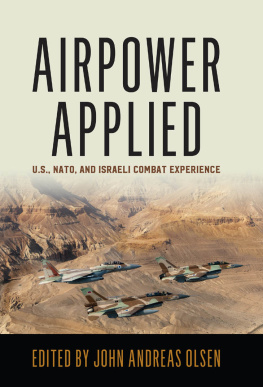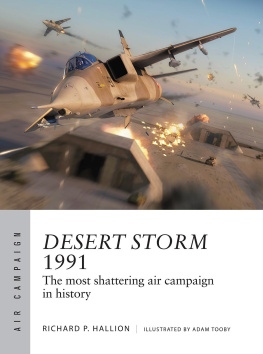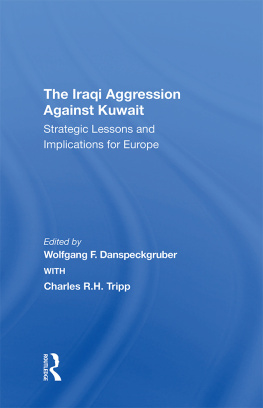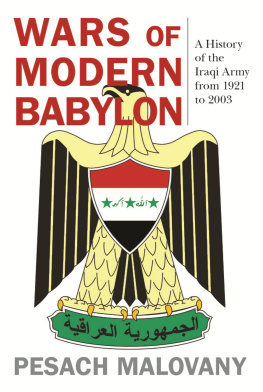STRATEGIC AIR POWER
in
DESERT STORM

First published in 2003 in Great Britain by Routledge
2 Park Square, Milton Park, Abingdon, Oxon, 0X14 4RN 270
Madison Ave, New York NY 10016
Transferred to Digital Printing 2006
Website: www.routledge.com
Copyright 2003 J. Olsen
British Library Cataloguing in Publication Data
Olsen, John Andreas
Strategic air power in Desert Storm. - (Routledge series. Studies in air power; no. 12)
1. Persian Gulf War, 1991 - Aerial operations, American
I. Title
956.7044248
ISBN 0-7146-5193-1 (cloth)
ISBN 0-7146-8195-4 (paper)
ISBN 97-8-1135-31297-8
ISSN 1368-5597
ISBN 978-1-1353-1297-8 (ePub)
Library of Congress Cataloging-in-Publication Data
Olsen, John Andreas, 1968
Strategic air power in Desert Storm / John Andreas Olsen.
p. cm. - (Routledge series-studies in air power, ISSN 1368-5597; 12)
Includes bibliographical references and index.
ISBN 0-7146-5193-1 - ISBN 0-7146-8195-4 (pbk.)
1. Persian Gulf War, 1991-Aerial operations, American. 2. Air power-United States-History-20th century. 3. United States. Air Force. I. Title. II. Series.
DS79.744.A47 047 2003
956.7044248-dc21
2002191220
All rights reserved. No part of this publication may be reproduced, stored in or introduced into a retrieval system or transmitted in any form or by any means, electronic, mechanical, photocopying, recording or otherwise, without the prior written permission of the publisher of this book.
Typeset in 11/12 Monotype Imprint by Cambridge Photosetting Services
Cover Illustration: F-117 A Nighthawk
Publishers Note
The publisher has gone to great lengths to ensure the quality of this reprint but points out that some imperfections in the original may be apparent
Printed and bound by CPI Antony Rowe, Eastbourne
To my wife, Tine.
Contents
FIGURES
TABLES
Political and military analysts and historians have all subjected the use of air power against Saddam Husseins regime in 1991 to intense scrutiny and the conclusions have run the entire gamut from hostile to laudatory. The influence of personality and the intellectual battle to establish the locus of air powers role are themes which recur continually in air power history: two other strategically minded airmen, Billy Mitchell and Sir Arthur Harris, shared Wardens propensity to press their case to the very limits of acceptability and beyond.
Here also John Olsen traces the complex inter-relationship between the various senior allied figures in the Administration, the Pentagon, and Central Command, and the way these interacted and influenced the air campaign. It was an immensely complicated and dynamic situation in which he demonstrates that, not only the major players themselves, but also the international media, public opinion, and the weather could and did have important and direct effects which are not always properly appreciated.
The debates which raged subsequently over the efficacy of air power in the Gulf, and afterwards the Balkans, cannot always be separated from the age old inter-service debates and arguments over resource allocation or, put more simply, money. Once the factor of future budget appropriations enters the equation it is usually safe to assume that some at least of the debate and the debaters will skew the argument over actual effects to suit their particular domestic political ends. Add to this brew the wider debates over the morality of the use of strategic air power, themselves stretching back to the earliest attempts to use air power in such a manner, together with nationalism and propaganda, and the result is a potent brew worthy of Macbeths witches. Too much of the extant writing on the 1991 air campaign thus far has been influenced by such factors and both the academic and air power communities, not to mention the foreign policy analysts, have cause to be grateful to John Olsen for his careful and dispassionate analysis, not only of the planning and effects of the strategic air campaign masterminded by men such as Dave Deptula and John Warden, but also of the target systems they aimed at, most particularly the Iraqi state and the hydra of the Baath Party. His analysis of the latter, drawing on a wide range of sources including highly placed sources within the Iraqi regime, is in itself of enormous value and importance. As the Iraqi leadership and the Baath party were in theory and reality a prime target of Warden, Deptula and the other air planners, an informed understanding of this aspect of the campaign should be central to our understanding of air powers successes and failures during the war. The author has been able to show not only what the US air planners in the famous Black Hole thought was happening, but also what senior figures in the Iraqi leadership, including Saddam, believed. The result is a much more rounded picture than before.
By analysing the structure of the Iraqi State in such depth Olsen is able to reach conclusions on the effectiveness of the air campaign which rest on better foundations than much of the more speculative writing of recent years.
This alone should make this volume required reading for those who are charged with thinking about the ways in which the international community should deal with the Iraqi regime of Saddam Hussein or those like him in the near future.
In January 1945 after five years of increasingly heavy Anglo-American air bombardment, Berlin was devastated with most buildings in the central districts reduced to burnt-out shells. Yet Hitler in his bunker and the Wehrmacht High Command in nearby Zossen could still send out orders to hundreds of units and receive reports by teleprinter and telephone landlines as well as by radio, and the German army could still move its forces by rail through Berlins often bombed but still operating marshalling yards. Nazi Germanys Minister of Propaganda Josef Goebbels could still broadcast nation-wide, and by short-wave radio heard around the world. Electrical power, the telephone service, public transport, piped water, sewage disposal, and the supply of basic necessities were still functioning with only brief interruptions, as did many cinemas: on 30 January 1945, the great colour spectacular Kolberg had a well-attended gala premiere.
Less than 48 hours after the air offensive against Iraq started on 17 January 1991, Baghdad was still mostly intact as it was to remain throughout the Gulf War, but all major military headquarters were wrecked, Saddam Hussein and his spokesmen could no longer broadcast on television or radio, and Baghdad was left without electricity, telephone service, public transport, piped water, or sewage disposal. Military telecommunications no longer worked, so that Iraqs leader and his military commanders were blind, deaf and mute in their paralysed capital city, unable to find out what was happening quickly enough to react usefully, unable to send out orders except by despatch-riders, and over a fibre-optic network that only reached a few headquarters. After another month of much less concentrated bombing, the vast Iraqi armed forces had lost virtually all their fighting capability, so that the American and coalition ground offensive that closed the war was virtually unopposed.
The 1991 air offensive was a very great victory, but a widespread misconception obscured its true meaning, with grave consequences for US military policies in the aftermath, eventually deforming the conduct of the 1999 Kosovo air war. It attributed the victory of air power to technological progress more than anything else, and specifically to the advent of precision-guided munitions, in the shape of laser-homing bombs, variously guided air-launched missiles, and sea-launched cruise missiles. Actually, air-launched missiles were used with much success as far back as 1943, and laser-homing bombs specifically were first used in the Vietnam war, without changing its outcome. Moreover, only a fraction of the air munitions used in the 1991 Gulf War were precision weapons, while the much higher proportion of precision weapons used in the 1999 Kosovo air war did not make it any more successful in fact that torturous 11-week air campaign is now universally viewed as a catalogue of errors. That is sufficient evidence that the victory of air power in 1991 was not determined by the technology but rather by its radically innovative application, both strategically and operationally.










